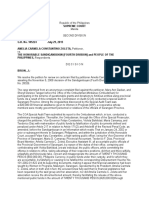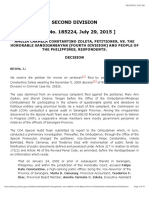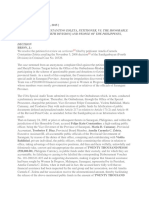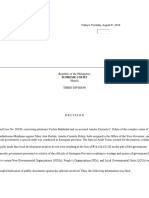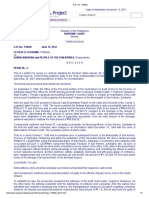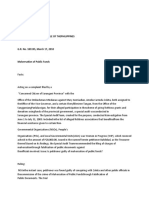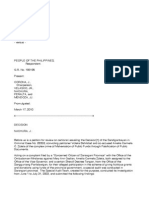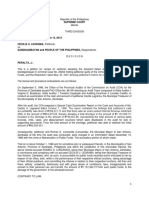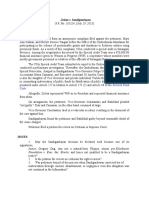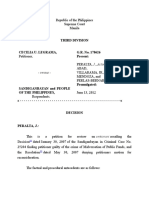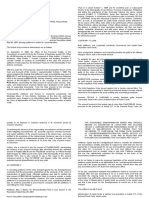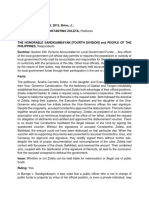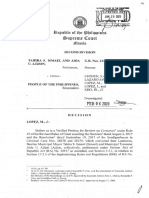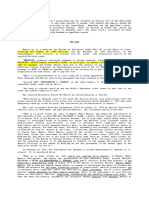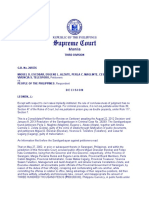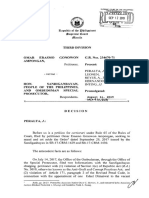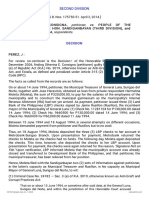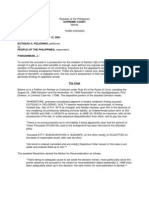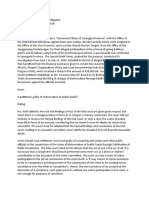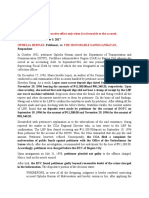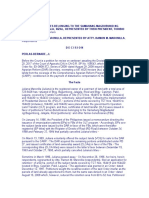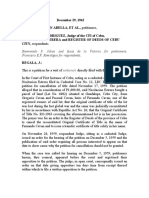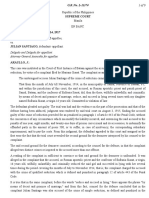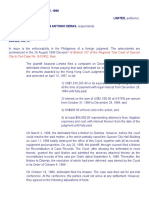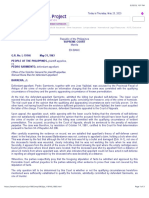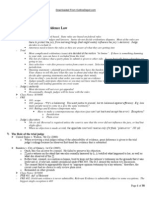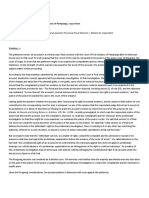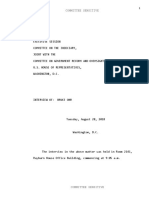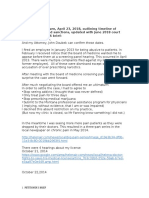AMELIA CARMELA CONSTANTINO ZOLETA,
Petitioner,
vs.
THE HONORABLE SANDIGANBAYAN [FOURTH DIVISION] and PEOPLE OF THE
PHILIPPINES, Respondents.
DECISION
BRION, J.:
We resolve the petition for review on certiorari filed by petitioner Amelia Carmela
1
Constantino Zoleta assailing the November 5, 2008 decision of the Sandiganbayan (Fourth
2
Division) in Criminal Case No. 28326.
The case stemmed from an anonymous complaint filed against the petitioner, Mary Ann
Gadian, and Sheryll Desiree Tangan before the Office of the Ombudsman-Mindanao
(Ombudsman) for participating in the scheme of questionable grants and donations to
fictitious entities using provincial funds. As a result of this complaint, the Commission on
Audit (COA) conducted a special audit in Sarangani Province. Among the irregularities
discovered by the Special Audit Team was a ₱20,000.00 financial assistance given to
Women in Progress (WIP), a cooperative whose members were mostly government
personnel or relatives of the officials of Sarangani Province.
The COA Special Audit Team submitted its report to the Ombudsman which, in turn,
conducted a preliminary investigation. Thereafter, the Ombudsman, through the Office of the
Special Prosecutor, charged the petitioner, Vice-Governor Felipe Constantino, Violeta
Bahilidad, Maria Camanay, and Teodorico Diaz with malversation of public funds by
falsification of public documents defined and penalized under Article 217 in relation to Article
171(2) and Article48 of the Revised Penal Code, as amended, before the Sandiganbayan in
an Information which reads: That on January 24, 2002 or prior or subsequent thereto in
Sarangani, Philippines, and within the jurisdiction of this Honorable Court, accused Felipe
Katu Constantino, a high-ranking public officer, being the Vice-Governor of the Province of
Sarangani, Maria D. Camanay, Provincial Accountant, Teodorico F. Diaz, Provincial Board
Member, Amelia Carmela C. Zoleta, Executive Assistant III, all accountable public officials of
the Provincial Government of Sarangani, by reason of the duties of their office, conspiring
and confederating with Violita Bahilidad, private individual, the public officers, while
committing the offense in relation to office, taking advantage of their respective positions, did
then and there wilfully, unlawfully and feloniously take, convert and misappropriate the
amount of TWENTY THOUSAND PESOS (₱20,000.00), Philippine Currency, in public funds
under their custody, and for which they are accountable, by falsifying or causing to be
falsified the corresponding Disbursement Voucher No. 101-2002-01-822 and its supporting
documents, making it appear that financial assistance had been sought by Women In
Progress, Malungon, Sarangani, represented by its President, Amelia Carmela C. Zoleta,
when in truth and in fact, the accused knew fully well that no financial assistance had been
requested by the said group and her association, nor did Amelia Carmela C. Zoleta and her
association receive the aforementioned amount, thereby facilitating the release of the above-
mentioned public funds in the amount of TWENTY THOUSAND PESOS
(₱20,000.00)through encashment by the accused at Land Bank of the Philippines (LBP)
Check No. 36481 dated January 24, 2002 issued in the name of the Violeta Bahilidad, which
amount they subsequently misappropriated to their personal use and benefit and despite
demand, the said accused failed to return the said amount to the damage and prejudice of
the government and the public interest of the aforesaid sum.
�CONTRARY TO LAW. (Emphasis in the original.)
3
On arraignment, the petitioner, Vice-Governor Constantino and Bahilidad pleaded "not
guilty." Diaz and Camanay, on the other hand, remained at large.
On March 22, 2006, the Sandiganbayan issued a Pre-trial Order. The People of the
4
Philippines, though the Office of the Special Prosecutor, filed its Comment and Ex Parte
Motion to Include Testimonial Evidence and Issue to Pre-trial Order essentially claiming that
5
the Pre-trial Order did not reflect certain testimonial evidence "as stated during the Pre-
Trial." 6
In its Order dated April 5, 2006, the Sandiganbayan amended certain portions of the Pre-trial
7
Order.
On April 25, 2006, Vice-Governor Constantino died in a vehicular accident, resulting in the
dismissal of the case against him.
In its decision dated November 5,2008, the Sandiganbayan found the petitioner and
Bahilidad guilty beyond reasonable doubt of the crime charged, and sentenced them to
suffer the indeterminate penalty of fourteen (14) years, eight (8) months and one (1) day, as
minimum, to sixteen (16) years, five (5) months, and eleven (11) days of reclusion temporal,
as maximum. It also imposed on them the additional penalty of perpetual disqualification
from holding any public office. The Sandiganbayan likewise directed them to pay back the
Province of Sarangani ₱20,000.00 plus interest, computed from January 2002 until fully
paid.8
The Sandiganbayan held that Vice-Governor Constantino had control and custody of the
funds by reason of his office, and that his signature was needed before a grant, donation, or
assistance could be released to a requesting party. According to the Sandiganbayan, Vice-
Governor Constantino approved the ₱20,000.00 disbursement despite the lack of the
required documentation.
The Sandiganbayan further ruled that Vice-Governor Constantino conspired with the other
accused in using a dummy organization WIP to facilitate the malversation. It explained that
the petitioner, who was Vice-Governor Constantino’s own daughter and who held the
position of Executive Assistant III in his office, committed the following acts: (a) ordered Mary
Ann Gadian, a computer operator at the Office of the Sangguniang Panlalawigan of
Sarangani, to make a letter-request for financial assistance using a nonexistent cooperative;
(b) directed Jane Tangan, the Local Legislative Staff Officer of the Office of the Vice-
Governor, to falsify the signature of WIP’s secretary, Melanie Remulta, on the request-letter;
and (c) certified and approved the disbursement voucher; and then presented it to Diaz,
Camanay, and Vice-Governor Constantino for their respective signatures.
The Sandiganbayan likewise ruled that falsification was a necessary means to commit the
crime of malversation.
THE PETITION FOR REVIEW ON CERTIORARI
In the present petition, the petitioner argued that: (a) the Sandiganbayan’s November 5,
2008 decision in Criminal Case No. 28326 was void because one of its signatories, Justice
Gregory Ong, was not a natural-born Filipino citizen per Kilosbayan Foundation v. Exec. Sec.
�Ermita, and hence not qualified to be a Sandiganbayan justice; (b) the totality of evidence
9
presented by the prosecution was insufficient to overcome the petitioner’s presumption of
innocence; and (c) the Sandiganbayan denied her due process when it issued its Order
dated April 5, 2006, amending certain portions of the pre-trial order without any hearing.
In its Comment, the People countered that Kilosbayan merely required Justice Ong to
10
complete "all necessary steps, through the appropriate adversarial proceedings in court, to
show that he is a natural born Filipino citizen and correct the records of his birth and
citizenship." It added that Kilosbayan did not categorically rule that Justice Ong was not a
natural-born Filipino who was disqualified from accepting an appointment to the position of
Associate Justice of this Court. The People further pointed out that the Court in Topacio v.
Ong already acknowledged Justice Ong’s actual physical possession and exercise of the
11
functions of the office of an Associate Justice of the Sandiganbayan.
The People likewise argued that the issue of sufficiency of the prosecution evidence is a
question of fact which is beyond the province of a petition for review on certiorari. It
nonetheless maintained that the Sandiganbayan’s findings were supported by the evidence
on record.
On the third issue, the People maintained that a person charged with willful malversation can
validly be convicted of malversation through negligence.
OUR RULING
We DENY the petition.
I. The Sandiganbayan’s November 5, 2008 decision is valid
The petitioner’s reliance in Kilosbayan to challenge the validity of the Sandiganbayan’s
decision is misplaced.
We point out that Kilosbayana rose from a petition for certiorari filed by both Kilosbayan
Foundation and Bantay Katarungan – both non-governmental organizations engaged in
public and civic causes – assailing then President Gloria Macapagal-Arroyo’s appointment of
Justice Ong as an Associate Justice of the Court on the ground that the latter was not a
natural born citizen. Contrary to the petitioner’s claim, Kilosbayan did not rule that Justice
Ong was not a natural-born Filipino (and hence unqualified to assume the position of a
Sandiganbayan Justice). The Court merely stated that Justice Ong cannot accept an
appointment to the position of Associate Justice of the Supreme Court or assume the
position of that office, "until he shall have successfully completed all the necessary steps,
through the appropriate adversarial proceedings in court to show that he is a natural-born
Filipino citizen and correct the records of his birth and citizenship."
12
At any rate, the Court has long settled the issue of Justice Ong’s citizenship. After the Court
promulgated Kilosbayan, Justice Ong immediately filed with the Regional Trial Court (RTC),
Branch 264, Pasig City, a petition for the amendment/ correction/ supplementation or
annotation of an entry in [his] Certificate of Birth, docketed as S.P. Proc No. 11767-SJ. In its
decision of October 24, 2007, the RTC granted Justice Ong's petition to be recognized as a
13
natural-born Filipino. Consequently, the RTC directed the Civil Registrar of San Juan, Metro
Manila to annotate in the Certificate of Birth of Justice Ong its (RTC’s) decision.
�The RTC denied the motions moving for a reconsideration of its decision.
In its six-page resolution in 2013, the Court En Banc also held that Justice Ong was a
natural-born citizen, thus:
The pronouncements of the Court in both GR No. 179895 and GR No. 180543, and the
finality of the decision rendered by the RTC on October 24, 2007,in S.P. No. 11767-
SJrecognizing Justice Ong as a natural born citizen of the Philippines and directing the
correction of the existing records of his birth and citizenship have already definitively settled
the subject of the query posed by SP Villa-Ignacio. 14
Even without this ruling, we hold that Justice Ong was a de facto officer during the period of
his incumbency as a Sandiganbayan Associate Justice. A de facto officer is one who is in
possession of an office and who openly exercises its functions under color of an appointment
or election, even though such appointment or election may be irregular. It is likewise defined
15
as one who is in possession of an office, and is discharging its duties under color of
authority, by which is meant authority derived from an appointment, however irregular or
informal, so that the incumbent be not a mere volunteer. Consequently, the acts of the de
16
facto officer are as valid for all purposes as those of a de jure officer, in so far as the public
or third persons who are interested therein are concerned. 17
In the light of these considerations, we find no basis to invalidate the November 5, 2008
decision of the Sandiganbayan in Criminal Case No. 28326.
II. Only questions of law should be raised in a Rule 45 petition
It is settled that the appellate jurisdiction of the Supreme Court over decisions and final
orders of the Sandiganbayan is limited only to questions of law; it does not review the factual
findings of the Sandiganbayan which, as a general rule, are conclusive upon the Court.
A question of law exists when there is doubt or controversy as to what the law is on a certain
state of facts. On the other hand, a question of fact exists when the doubt or controversy
arises as to the truth or falsity of the alleged facts. The resolution of a question of fact
necessarily involves a calibration of the evidence, the credibility of the witnesses, the
existence and the relevance of surrounding circumstances, and the probability of specific
situations.
18
In the present petition, the petitioner alleges that the presented evidence were insufficient to
support a conviction. She thus seeks a re-evaluation of the Sandiganbayan’s appreciation of
the evidence presented, including the credibility of witnesses and the probative value of their
testimonies. The petitioner likewise wants the Court to take a closer look into her claim that
the charges against them were politically motivated.
To our mind, the Sandiganbayan’s findings that: the testimonies of Gadian and Tangan were
credible and worthy of belief; WPI was an unregistered cooperative; the signatures of the
petitioner and her co-accused on the disbursement voucher were authentic; Remulta’s
signature had been forged; and the charges against the accused were not politically
motivated, are questions of fact, as these matters were resolved after a calibration of the
pieces of evidence presented during trial. The Court will not anymore weigh these pieces of
evidence in the absence of a clear showing that these findings had been arrived at arbitrarily
or are devoid of support in the records.
�At any rate, we hold that the Sandiganbayan correctly convicted the petitioner of the complex
crime of malversation of public funds through falsification of public documents.
Malversation may be committed by appropriating public funds or property; by taking or
misappropriating the same; by consenting, or through abandonment or negligence, by
permitting any other person to take such public funds or property; or by being otherwise
guilty of the misappropriation or malversation of such funds or property. 19
The elements common to all acts of malversation under Article 217 of the Revised Penal
Code, as amended, are the following: (a) that the offender be a public officer; (b) that he had
custody or control of funds or property by reason of the duties of his office; (c) that those
funds or property were public funds or property for which he was accountable; and (d) that
he appropriated, took, misappropriated or consented, or through abandonment or
negligence, permitted another person to take them. All these elements have been
established by the prosecution.
First, it is undisputed that all the accused, except Bahilidad, are all public officers. A public
officer is defined in the Revised Penal Code as "any person who, by direct provision of the
law, popular election, or appointment by competent authority, shall take part in the
performance of public functions in the Government of the Philippine Islands, or shall perform
in said Government or in any of its branches public duties as an employee, agent, or
subordinate official, of any rank or class. Constantino was the Vice-Governor of Sarangani
Province, while the petitioner, Camanay, and Diaz were occupying the positions of Executive
Assistant (at the Office of the Vice-Governor), Provincial Accountant, and Provincial Board
Member, respectively.
Second, the funds misappropriated are public in character, as they were funds belonging to
the Province of Sarangani.
Third, Vice-Governor Constantino and Camanay were accountable public officers. Under the
Government Auditing Code of the Philippines, an accountable public officer is a public officer
who, by reason of his office, is accountable for public funds or property. The Local
Government Code expanded this definition with regard to local government officials. Section
340 of the LGC reads:
Section 340. Persons Accountable for Local Government Funds. – Any officer of the local
government unit whose duty permits or requires the possession or custody of local
government funds shall be accountable and responsible for the safekeeping thereof in
conformity with the provisions of this title. Other local officials, though not accountable by the
nature of their duties, may likewise be similarly held accountable and responsible for local
government funds through their participation in the use or application thereof. (Emphasis
ours.)
Local government officials become accountable public officers either (1) because of the
nature of their functions; or (2) on account of their participation in the use or application of
public funds.20
As a required standard procedure, the signatures of, among others, the Vice-Governor and
the Provincial Accountant are needed before any disbursement of public funds can be made.
No checks can be prepared and no payment can be effected without their signatures on a
disbursement voucher and the corresponding check. In other words, any disbursement and
release of public funds require their approval. Thus, Constantino and Camanay, in their
�capacities as Vice-Governor and Provincial Accountant, had control and responsibility over
the subject funds.
Finally, Vice-Governor Constantino and Camanay appropriated, took, misappropriated or
consented, or through abandonment or negligence, permitted another person to take the
public funds when they signed Disbursement Voucher No. 101-2002-01-822. The term
voucher, when used in connection with disbursement of money, implies some instrument that
shows on what account or by what authority a particular payment has been made, or that
services have been performed which entitle the party to whom it is issued to payment.
Corollarily, when an authorized person approves a disbursement voucher, he certifies to the
correctness of the entries therein, among others: that the expenses incurred were necessary
and lawful, the supporting documents are complete, and the availability of cash therefor. He
also attests that the person who performed the services or delivered the supplies, materials,
or equipment is entitled to payment. 21
Notably, the signatures of Camanayand Vice-Governor Constantino also appeared on the
Allotment and Obligation Slip (ALOBS) and in Land Bank Check No. 0000036481,
respectively. Their respective signatures in these documents allowed Bahilidad to encash
₱20,000.00. We also point out that although the purported request was made by the WIP,
the check was made payable to a private person, that is, Bahilidad. According to Helen
Cailing, the leader of the COA Special Audit Team, there were no supporting documents
attached to this disbursement voucher proving that Bahilidad was indeed the treasurer of
WIP.
We also agree with the Sandiganbayan’s ruling that falsification was a necessary means to
commit the crime of malversation. Article 171, paragraphs (2) and (5) of the Revised Penal
Code, provides:
ART. 171. Falsification by public officer, employee or notary or ecclesiastic minister. - The
penalty of prision mayor and a fine not to exceed 5,000 pesos shall be imposed upon any
public officer, employee, or notary who, taking advantage of his official position, shall falsify a
document by committing any of the following acts:
xxxx
2. Causing it to appear that persons have participated in any act or proceeding when they
did not in fact so participate;
xxxx
In the present case, the records showed that the petitioner ordered Tangan to sign above the
name of Remulta in the letter-request to make it appear that the latter, as WIP Secretary,
consented to the request for financial assistance. We note, too, that this letter-request was
made on January 24, 2002, but Gadianante dated it to January 7, 2002, so that the
transaction would not look suspicious (considering that both the disbursement voucher and
check were also dated January 24, 2002).
The Presence of Conspiracy
Conspiracy exists when two or more persons come to an agreement concerning the
commission of a felony and decide to commit it. Conspiracy does not need to be proven by
�direct evidence and may be inferred from the conduct ―before, during, and after the
commission of the crime ― indicative of a joint purpose, concerted action, and concurrence of
sentiments. In conspiracy, the act of one is the act of all. Conspiracy is present when one concurs
with the criminal design of another, as shown by an overt act leading to the crime committed. It
may be deduced from the mode and manner of the commission of the crime. 22
In the present case, the records established with moral certainty that the petitioner and her
co-accused acted in concert to achieve a common objective. The presence of conspiracy
between the petitioner and her co-accused was explained by the Sandiganbayan as follows:
xxxx
Moreover, the testimony of Gadian and Tangan indubitably established that accused
Constantino and Zoleta took advantage of their official positions. Zoleta ordered Gadian to
make a request using a nonexistent cooperative. She ordered Tangan to falsify the signature
of Remulta in the request letter. Both followed the directive of Zoleta, being their superior, the
Executive Assistant and the daughter of the Vice-Governor who places her initials before the
Vice-Governor affixes his own signature. Despite the irregularity, accused Constantino
approved the disbursement. The facts taken together would prove the existence of
conspiracy. Zoleta, as president of an in existent association and a co-terminous employee
at the office of her father, initiated the request for obligation of allotments and certified and
approved the disbursement voucher. There is no doubt that Constantino facilitated the illegal
release of the fund by signing the questioned voucher. Without the signatures of accused
Constantino, Zoleta, and Bahilidad, the amount could not have been disbursed on that
particular day. When the voucher with its supporting documents was presented to accused
Constantino, Diaz, and Camanay for approval and signature, they readily signed them
without further ado, despite the lack of proper documentation and noncompliance of the
rules. Zoleta had contact with the payee of the check, Bahilidad, and received the amount.
Their combined acts, coupled with the falsification of the signature of Remulta, all lead to the
conclusion that the accused conspired to defraud the government.
The concurrence of wills or unity of purpose and action between the accused is
indubitable. A careful scrutiny of the records revealed that indeed: (a) the petitioner signed
1âwphi1
the letter-request for financial assistance, and this was approved by Diaz and Vice-Governor
Constantino; (b) the ALOBS was signed by Camanay; (c) Disbursement Voucher No. 101-
2002-01-822 was signed by Vice-Governor Constantino, Diaz and Camanay; and (d) Land
Bank Check No. 0000036481 was signed by Vice-Governor Constantino.
The connivance between the accused is made more glaring by the fact that the entire
transaction – from the letter-request, to the approval of the disbursement voucher, until the
processing and release of the check – was completed in only one day. We note, too, that the
disbursement had been approved even without the required supporting documents such as
the Articles of Cooperation and Certificate from the Cooperative Development Authority.
There was also noncompliance with the COA-prescribed auditing and accounting guidelines
on the release of fund assistance to NGOs, such as the required monitoring and inspection
report either by the Office of the Provincial Agriculturist or the Provincial Engineering Office.
As earlier stated, the purported request was made by WIP, but the check was made payable
to Bahilidad (despite the COA’s findings that there were no supporting documents proving
that she was WIP’s treasurer). We are aware that Bahilidad was acquitted by this Court in
G.R. No. 185195 – a case where she questioned her conviction by the Sandiganbayan.
23
This does not preclude us, however, from ruling that the other accused, i.e., Vice-Governor
Constantino, Diaz, Camanay, and the petitioner, conspired with each other to attain a
�common objective. We point out that Bahilidad’s acquittal was anchored on the fact that she
had no hand in the preparation, processing or disbursing of the check issued in her name. It
cannot be denied in the present case that the petitioner, Vice-Governor Constantino, Diaz,
and Camanay, all participated in the preparation and processing of Disbursement Voucher
No. 101-2002-01-822 as evidenced by their respective signatures affixed there. Sanggunian
24
Panlalawigan Bookbinder Gadian, in fact, witnessed Vice-Governor Constantino, Camanay,
25
and Diaz sign these documents.
In Barriga v. Sandiganbayan, we ruled that:
26
It must be stressed that a public officer who is not in charge of public funds or property by
virtue of her official position, or even a private individual, may be liable for malversation or
illegal use of public funds or property if such public officer or private individual conspires with
an accountable public officer to commit malversation or illegal use of public funds or
property.
III. No denial of due process
The petitioner claims that he was denied due process when the Sandiganbayan granted the
prosecution’s motion to amend certain portions of the pre-trial order without any hearing. In
essence, the petitioner argues that she could not be convicted of malversation through
consent, abandonment, or negligence because this allegation was not contained in the
Information.
The petitioner’s argument lacks merit.
Malversation is committed either intentionally or by negligence. The dolo or the culpa present
in the offense is only a modality in the perpetration of the felony. Even if the mode charged
differs from the mode proved, the same offense of malversation is involved and conviction
thereof is proper. All that is necessary for conviction is sufficient proof that the accountable
officer had received public funds, that he did not have them in his possession when demand
therefor was made, and that he could not satisfactorily explain his failure to do so. Direct
evidence of personal misappropriation by the accused is hardly necessary as long as the
accused cannot explain satisfactorily the shortage in his accounts. 27
In People v. Consigna, et al., the Court first ruled that an accused charged with wilful
28
malversation can be validly convicted of malversation through negligence where the
evidence sustains the latter mode of perpetrating the offense.
Similarly, in People v. Ochoa, the Court stated that [e]ven when the Information charges
29
wilful malversation, conviction for malversation through negligence may still be adjudged if
the evidence ultimately proves that mode of commission of the offense.
In Tubola, Jr. v. Sandiganbayan, we affirmed the accused’s conviction of malversation of
30
public funds under Article 217 of the Revised Penal Code, and reasoned out as follows:
Besides, even on the putative assumption that the evidence against petitioner yielded a case
of malversation by negligence but the information was for intentional malversation, under the
circumstances of this case his conviction under the first mode of misappropriation would still
be in order. Malversation is committed either intentionally or by negligence. The dolo or the
culpa present in the offense is only a modality in the perpetration of the felony. Even if the
�mode charged differs from the mode proved, the same offense of malversation is involved
and conviction thereof is proper. A possible exception would be when the mode of
commission alleged in the particulars of the indictment is so far removed from the ultimate
categorization of the crime that it may be said due process was denied by deluding the
accused into an erroneous comprehension of the charge against him. That no such prejudice
was occasioned on petitioner nor was he beleaguered in his defense is apparent from the
records of this case. (Underscoring and emphasis in the original.)
The Proper Penalty
We modify the maximum term of the penalty imposed on the petitioner by the
Sandiganbayan, from sixteen (16) years, five (5) months, and eleven (11) days to eighteen
(18) years, two (2) months, and twenty one (21) days of reclusion temporal, in accordance
with Articles 48 and 21 7 of the Revised Penal Code, as amended, in relation to the
Indeterminate Sentence Law. WHEREFORE, in the light of all the foregoing, we DENY the
31
petition. Accordingly, we AFFIRM the November 5, 2008 decision of the Sandiganbayan
(Fourth Division) in Criminal Case No. 28326 with the MODIFICATION that the maximum
term of the penalty imposed on the petitioner be increased from sixteen ( 16) years, five ( 5)
months, and eleven (11) days to eighteen (18) years, two (2) months and twenty one (21)
days of reclusion temporal.
SO ORDERED.

